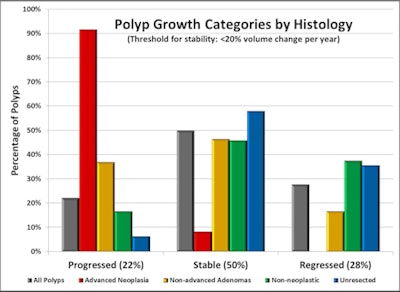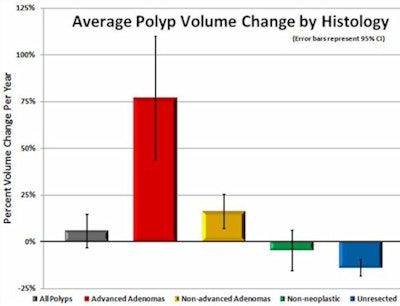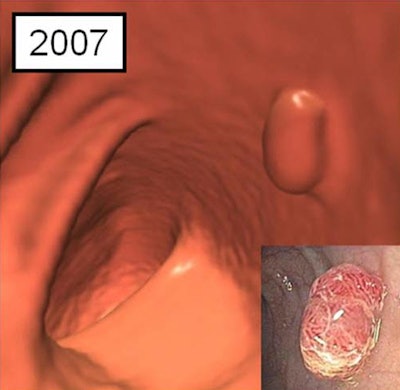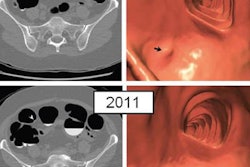
A large eight-year screening study suggests that 6- to 9-mm colorectal polyps do not grow rapidly in vivo to pose a significant danger of cancer and therefore don't need to be removed immediately, U.S. researchers reported on Friday at the 2013 European Society of Gastrointestinal and Abdominal Radiology (ESGAR) meeting in Barcelona, Spain.
The study of more than 22,000 individuals is good news for virtual colonoscopy (also known as CT colonography or CTC), as it suggests that the screening exam can be trusted to keep an eye on small lesions over several years in a controversial watch-and-wait practice known as polyp surveillance.
Investigators from the University of Wisconsin and the National Naval Medical Center (NNMC) had hoped that long-term follow-up would prove their hypothesis: namely, that the few lesions that grow to become potential cancer threats do so slowly enough to be seen and removed at follow-up screening CTC over several years.
Among the screening subjects, the group found 306 small colorectal polyps (6-9 mm) and referred the patients to CTC surveillance for two to three years, reported Dr. Perry Pickhardt, Dr. David Kim, Dr. Dustin Pooler, and colleagues, along with Dr. Brooks Cash, chief of gastroenterology at NNMC.
At follow-up, just one-fifth of the lesions had grown in volume by more than 20%, and nearly all of the growing lesions were advanced adenomas in the form of pedunculated polyps, which are readily seen and removed at conventional colonoscopy, the group reported.
 Results showed that 91% of advanced adenomas (21/23) progressed, and all 23 grew (37% nonadvanced adenomas, 17% nonneoplastic lesions, 6% unproven). In all, 93% of progressing polyps with proven histology were neoplastic, and 10% resolved. All images courtesy of Dr. Perry Pickhardt.
Results showed that 91% of advanced adenomas (21/23) progressed, and all 23 grew (37% nonadvanced adenomas, 17% nonneoplastic lesions, 6% unproven). In all, 93% of progressing polyps with proven histology were neoplastic, and 10% resolved. All images courtesy of Dr. Perry Pickhardt."It looks like there really can be this noninvasive way to not automatically refer individuals with small 6- to 9-mm polyps to colonoscopy," Pickhardt, a professor of radiology at the University of Wisconsin, told AuntMinnie.com. "The key thing is that over 90% of the polyps that grow are advanced adenomas, which make up only a tiny fraction of all polyps." The ones that grow "tend to grow quite obviously, and the ones that don't grow get smaller or even disappear," he said.
Concurrent with Friday's presentation at ESGAR 2013, results of the National Institutes of Health-funded study were also published in Lancet Oncology (June 7, 2013).
Time to kill
Colorectal cancer, because it nearly always develops slowly from benign growths in the colon and rectum, presents unique opportunities for screening. Prior studies suggest there is time -- perhaps a decade of leeway -- during which patients with large colorectal polyps can have them removed before cancer develops, the study team noted.
Researchers are mostly in agreement that polyps smaller than 1 cm present almost no risk of colorectal carcinoma, and polyps 5 mm and smaller are very unlikely to harbor cancer. But because all polyps detected at conventional colonoscopy are typically removed during the procedure, little is known about the behavior of polyps left in vivo. The finding that small lesions might be left inside the patient because so few grow could have an important effect on colorectal cancer screening.
"We have no idea what happens with these things over time, and the bottom line is that CTC is the ideal test for this kind of noninvasive in vivo surveillance, which was basically the study," Pickhardt said.
Aiming to assess how many and what kinds of lesions might eventually present a danger, the study group analyzed the polyp surveillance cohort to determine whether growth rates were predictive of neoplasia, advanced lesions, and clinical importance. Pickhardt led the virtual colonoscopy screening effort at the University of Wisconsin, while Cash oversaw the program at NNMC.
Virtual colonoscopy surveillance was offered as an option for individuals with one or two small 6- to 9-mm polyps (C-RADS C2 category lesions) at VC. The surveillance interval began at one to two years after virtual colonoscopy, and it was expanded to a maximum of three years by the end of the trial, Pickhardt said. When polyps were found to be not progressing at CTC, the interval was expanded to three to five years. Patients with polyps showing growth of 1 mm or more at interval CTC were referred for conventional colonoscopy and polypectomy.
At CTC, three experienced radiologists performed a polyp assessment on dedicated workstations (V3D-Colon, Viatronix). Polyps were divided into the following histologic categories:
- Neoplastic polyps (advanced adenomas)
- Nonneoplastic polyps (hyperplastic, other)
- Histology unknown (resolved, ongoing surveillance)
They were also divided into growth categories, i.e., progressing, stable, or regressing (or resolving). Polyps showing volume growth of 20% or more per year or growth to 1 cm or larger were considered progressing.
Growth limited to advanced adenomas
The final cohort consisted of 243 adults (152 men, 91 women; mean age, 57.4 years) with a mean surveillance interval of 2.3 ± 1.4 years. Thirty patients underwent more than 1 surveillance CTC exam.
There were 306 small (6-9 mm) polyps, with a mean linear size of 7.2 ± 1.1 mm at index CTC. The mean polyp volume at index CTC was 83.4 ± 60.4 mm3.
Additional polyp features were as follows:
- Morphology: sessile (n = 237), flat (n = 36), pedunculated (n = 33)
- Location: rectum (n = 46), sigmoid (n = 87), descending (n = 27), transverse (n = 63), ascending (n = 58), cecum (n = 24)
- Histology: 107 adenomas (23 advanced), 24 nonneoplastic, 32 completely regressed, 142 still in surveillance
Growth was almost entirely limited to advanced adenomas, Pickhardt said. In fact, 91% of advanced adenomas (21/23) progressed. All 23 adenomas grew, and 93% of progressing polyps with proven histology were neoplastic. In addition, 10% of polyps resolved.
"That's another piece that's been controversial -- whether they regress -- and it looks like they could ... in fact, almost one-third of polyps got smaller and about 10% completely disappeared," Pickhardt said. "It makes sense that some would disappear because if every polyp mattered, 50% of us would have cancer, and in the end only 5% of us at most are ever going to get colon cancer."
 Nearly all polyps that grew over time manifested advanced histologies.
Nearly all polyps that grew over time manifested advanced histologies.

Progression according to morphology showed that 45% were pedunculated polyps, 21% were sessile polyps, and 8% were flat polyps.
According to location, progression was greatest in cecal (38%) and rectal (35%) polyps, followed by polyps in the descending (26%), sigmoid (23%), ascending (16%), and transverse colon (10%).
An absolute polyp volume of more than 180 mm3 at surveillance CTC identified proven advanced neoplasia (including one delayed cancer) with a sensitivity of 92% (22/24 polyps), specificity of 94% (266/282), positive predictive value of 58% (22/38), and negative predictive value of 99% (266/268).
Only 16 (6%) of the 6- to 9-mm polyps exceeded 10 mm at follow-up, the researchers found.
Only large lesions pose a danger
In vivo volumetric assessment of small colorectal polyps at CTC represents a powerful biomarker for gauging their clinical importance, Pickhardt concluded. Advanced adenomas tended to show relatively rapid interval growth by volume, while nonadvanced adenomas showed intermediate behavior and other polyps remained stable or regressed, he said.
"The ones that grew volumetrically and the ones that got bigger were much more likely to be important histologically than the ones that did not grow; the ones that grew to over 1 cm by linear size were more likely to have tubulovillous or villous histology," Pickhardt said. By location, rectal and cecal polyps tended to grow a bit more.
Flat-polyp growth was a bust. "Most cancers are polypoid pedunculated lesions, and, unfortunately, that gets completely twisted around in the literature," Pickhardt said. Even in Japan and Korea, where cases of flat polyps are aggregated and sent to referral centers, researchers rarely see aggressive cases. "The flat polyps we see certainly didn't take off," he said.
The take-home message is clear enough, he said: "By simply watching these things grow, we can sort out which ones matter and which ones don't. The ones that get bigger, you take out. The ones that stay the same or get smaller, we're in no rush. Most of these are never going to need to come out."
Still to come is more follow-up on patients with polyps in surveillance. "The one thing I don't know about is what happens to stable polyps: Do they eventually take off? Maybe a few will, but by and large we're concentrating on the ones that matter," Pickhardt said.




















